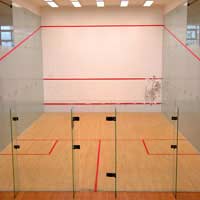Squash: Introduction to the Court and the Ball

The enclosed nature of the squash court means there is a claustrophobic element to the game especially if you happen to be on the receiving end of a real onslaught. If you are having one of these days when nothing seems to be coming off, or you are punching above your weight by playing a more skilful individual, then heading for the exit can’t come a moment too soon.
The intensity of the battle is all the more because you are both, in effect, playing on the same side of the net, in this case represented by the front wall. This is bisected by two lines, the lower service line and the upper front wall line. At the bottom you will find a board manufactured from metal and known as the tin. The ball is deemed to be out when it strikes the tin, the material providing an audible indication of this.
The surface of the court is bisected by the short line, which joins each of the side walls. From the middle of the short line, the half court line cuts the rear part of the court into two, ending at the back wall. Each of these rear-court “quarters” contains a service box.
Door To The Court
Both the side wall and back wall lines on the corresponding surfaces mark the playing area. Below the line, the ball is “good” i.e. in play; above is out of play. The back wall also incorporates the door to the court, which can either be used for triumphant exits or provide the escape route mentioned earlier.Court specifications of 9,750mm in length and 6,400mm in width are stipulated by the World Squash Federation. A doubles court is a further 1,220 mm in width. In terms of the floor, it must be constructed from a material that offers a certain level of absorbency without becoming slippery and has a limited amount of spring. The floor also has to offer uniform bounce and ball performance across its entire area.
Beginners’ Model
The performance of the ball, manufactured from rubber, will be determined in part by which grade it is. There are four basic levels of ball, ranging from larger models with extended hang-time i.e. the amount of time it takes to complete a bounce, to traditional sized ones that are designed solely to be used by advanced and tournament players. Not surprisingly, the larger ball is perfect for those starting out in the game.Squash matches are preceded by a warm-up, which serves in part to increase the temperature inside the ball to make it perform better. However Dunlop, which dominates the global squash ball industry, markets its beginners’ model, the Max, with the promise of an instant bounce, which means there is no need to “warm-up” the ball prior to play.
It is important to match the ball to your ability. Using a more advanced ball will not only prove frustrating but it will also inhibit the development of your technical skills. There is no fast-track to excellence in the sport. Improvement comes with practice, coaching and that all-important experience of competing head to head on the court.
- Squash: Tackling Unforced Errors
- Squash: Crosscourt Drive
- Safety on Court and some Basic Rules
- Squash: Service and Service Return
- Basic Squash Forehand and Backhand
- Squash: Getting to Grips with your Racket
- Squash: Get your Tactics Right
- Squash: The Right Mentality
- Squash: Volleying
- What is the Boast?
- Drop and Lob Shots

